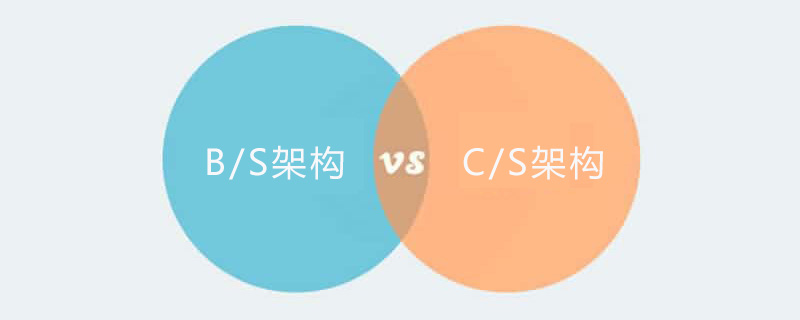B/S和C/S的区别:1、C/S建立在专用网络上,通过专门服务器服务;而B/S建立在广域网上,不必有专门的网络硬件环境。2、C/S一般面向相对固定的用户群,对信息安全的控制能力很强;而B/S面向不可知的用户群,对安全的控制能力相对弱。

C/S架构是什么?
C/S架构,即Client/Server(客户端/服务器)架构,是一个典型的两层架构。通过将任务合理分配到客户端和服务器,降低了系统的通讯开销,需要安装客户端才可进行管理操作。
客户端包含一个或多个运行在用户计算机上的程序,有两个服务器,一个是数据库服务器,通过数据库连接客户端访问服务器端数据;另一种是套接字服务器,服务器通过套接字程序与客户端通信。
客户端和服务器端的程序不同,用户的程序主要在客户端,服务器端主要提供数据管理、数据共享、数据及系统维护和并发控制等,客户端程序主要完成用户的具体的业务。
开发比较容易,操作简便,但应用程序的升级和客户端程序的维护较为困难。
B/S架构是什么?
B/S架构,即Brower/Server(浏览器/服务器)架构。它由逻辑上相互分离的表示层、业务层和数据层构成。表示层向客户提供数据,业务层实施业务和数据规则,数据层定义数据访问标准;三层体系结构中的核心是组件对象模型。
B / S系统统一了客户端,无需特殊安装,拥有Web浏览器即可;它将系统功能实现的核心部分集中到服务器上,简化了系统的开发、维护和使用。可以在服务器上安装数据库,然后浏览器通过mysql等数据库来进行数据交互。
B/S架构和C/S架构的区别
1、建立基础不同
C/S是建立在局域网的基础上的;而,B/S是建立在广域网的基础上的。
2、硬件环境不同
C/S 一般建立在专用的网络上,小范围里的网络环境,局域网之间再通过专门服务器提供连接和数据交换服务。
B/S 建立在广域网之上的,不必有专门的网络硬件环境,例与电话上网,租用设备,信息自己管理。有比C/S更强的适应范围, 一般只要有操作系统和浏览器就行。
3、对安全要求不同
C/S 一般面向相对固定的用户群,对信息安全的控制能力很强。一般高度机密的信息系统采用C/S 结构适宜,可以通过B/S发布部分可公开信息.
B/S 建立在广域网之上, 对安全的控制能力相对弱, 面向是不可知的用户群。
4、对程序架构不同
C/S 程序更加注重流程, 可以对权限多层次校验, 对系统运行速度可以较少考虑。
B/S对安全以及访问速度的多重考虑, 建立在需要更加优化的基础之上。 比C/S有更高的要求 B/S结构的程序架构是发展的趋势, 从MS的。Net系列的BizTalk 2000 Exchange 2000等, 全面支持网络的构件搭建的系统。 SUN 和IBM推的JavaBean 构件技术等,使 B/S更加成熟。 例如智赢IPOWER,采用AJAX和数据存储优化技术,相比一般B/S架构软件速度提高30%至99%。
5、软件重用不同
C/S 程序不可避免的考虑整体性, 构件的重用性不如在B/S要求下的构件的重用性好。
B/S对的多重结构,要求构件相对独立的功能, 能够相对较好的重用。
6、系统维护不同
C/S 程序由于整体性, 必须整体考察, 处理出现的问题以及系统升级。 升级难, 可能是再做一个全新的系统
B/S 构件组成,方面构件个别的更换,实现系统的无缝升级。 系统维护开销减到最小;用户从网上自己下载安装就可以实现升级。
7、处理问题不同
C/S 程序可以处理用户面固定, 并且在相同区域, 安全要求高需求, 与操作系统相关。 应该都是相同的系统
B/S 建立在广域网上, 面向不同的用户群, 分散地域, 这是C/S无法作到的;与操作系统平台关系最小。
8、用户接口不同
C/S 多是建立的Window平台上,表现方法有限,对程序员普遍要求较高
B/S 建立在浏览器上, 通过WEB服务或其他公共可识别描述语言可跨平台,使用更灵活。不仅可应用在Window平台上,还可应用于unix/Linux等平台。
9、信息流不同
C/S 程序一般是典型的中央集权的机械式处理, 交互性相对低
B/S 信息流向可变化, B-B B-C B-G等信息、流向的变化, 更象交易中心。
以上就是本篇文章的全部内容,希望能对大家的学习有所帮助。更多精彩内容大家可以关注php中文网相关教程栏目!!!
以上就是B/S架构和C/S架构的区别是什么的详细内容,更多请关注php中文网其它相关文章!

每个人都需要一台速度更快、更稳定的 PC。随着时间的推移,垃圾文件、旧注册表数据和不必要的后台进程会占用资源并降低性能。幸运的是,许多工具可以让 Windows 保持平稳运行。

Copyright 2014-2025 //m.sbmmt.com/ All Rights Reserved | php.cn | 湘ICP备2023035733号